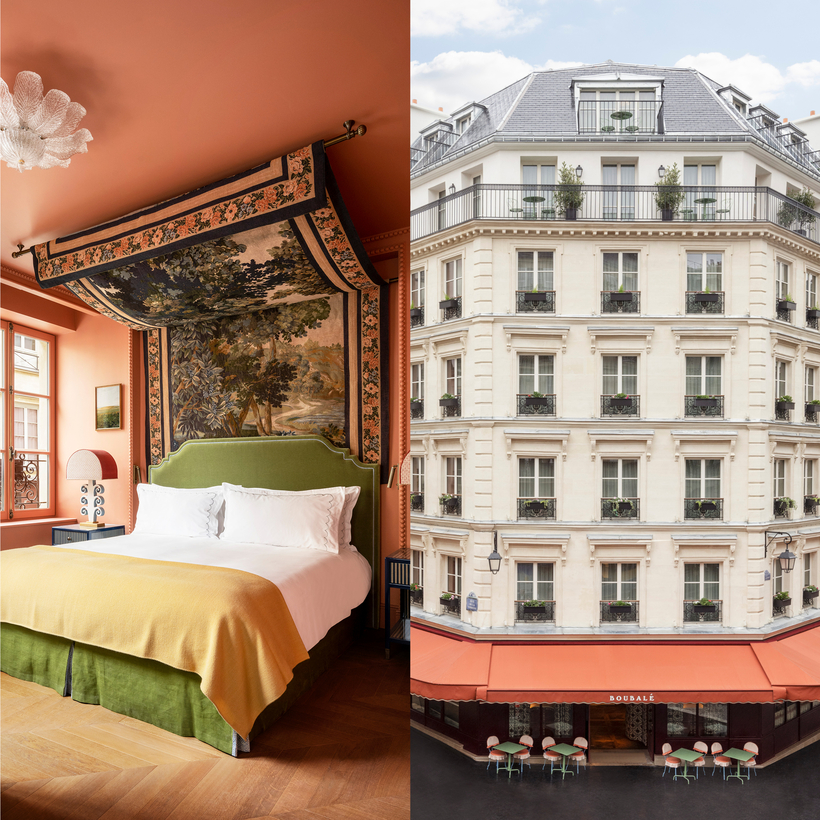The Marais, comprising the Third and Fourth Arrondissements of Paris, has always had spectacular architecture and exceptional museums. But in the 80s, when I first arrived in France and began wandering its lanes, the trauma caused by the deportation of almost 50,000 citizens from Paris’s largest Jewish quarter during World War II was still raw.
It’s been transforming itself ever since. The recent opening of Le Grand Mazarin, a five-star hotel at the corner of the Rue des Archives and the Rue de la Verrerie, has crowned these efforts. The idea of opening an extravagant hotel across the street from the BHV, which when I arrived was an endearingly frumpy normal-people department store with a much-loved hardware store in its basement, would have seemed laughable in those days.

Today, this same corner is where the 50-room, 11-suite Le Grand Mazarin stands. The location was deliberately chosen by sisters Leslie Kouhana and Kimberley Cohen, whose Ashkenazi maternal grandparents immigrated to the Marais at the end of the 19th century. It’s the first urban hotel of their Maisons Pariente hotel group, which also includes Hôtel Crillon le Brave, in Provence, and Lou Pinet, in St. Tropez.

I was first drawn to the Marais because it was different from the rest of Paris in a way that made me feel at home there. There was none of the bourgeois grandeur that had grown up along the avenues Baron Haussmann built in the 19th century. Instead, the Marais, with narrow, snaking streets and soot-covered houses, was quiet, secretive, and cerebral, an ideal place to reconcile the romantic fantasies I’d had about living in Paris with the reality of actually being there.
For me, as a former New Yorker, the Jewish culture of Le Marais felt comforting and familiar. I loved the Rue des Rosiers, with its braided sesame- and poppy-seed rolls, sticky buns filled with raisins and caramel-glazed walnuts. The big, messy falafel sandwiches with pickled vegetable slaw, hot sauce, and strong gusts of cumin and coriander were best of all. Those bright, foreign flavors were uncommon then, and I devoured them while standing on a chilly street corner. Chez Jo Goldenberg, one of the area’s landmarks, was bombed by a Palestinian militant group in 1982, killing six and injuring 22. It reopened but ultimately closed in 2006.

Although Jews had lived in the Marais since the 13th century, it became a refuge for thousands more fleeing the pogroms during the 19th century. The newcomers called the neighborhood the Pletzl, “the Little Place” in Yiddish. In the late 70s, a part of the neighborhood emerged as a hub for Paris’s gay community. Perhaps they intuited they’d be safe from persecution in a neighborhood inhabited by people who had been subjected to it for generations.

I’m not a big fan of tearooms, but there were several charming ones, and also some wonderful bookstores, serviceable antique dealers, and one-of-a-kind cobwebby shops tucked away. There was even a storefront that sold Nepalese ceramics. All are long gone.
The aristocratic southwestern corner of the neighborhood is anchored in the magnificent, arcaded Place des Vosges, built by Henry IV, who lived in one palace at the end and put his wife in a different one, across the square. There, travelers would find the one serious restaurant of the Marais, the three-Michelin-starred L’Ambroisie. It was just down the arcade from the best place to stay, Le Pavillon de la Reine, located in the queen’s former palace.

The district eventually became home to the studios of some of the most important fashion designers of the 20th century, notably Azzedine Alaïa and Yohji Yamamoto.
The big, messy falafel sandwiches with pickled vegetable slaw, hot sauce, and strong gusts of cumin and coriander were best of all.
Like so many mythic neighborhoods in big Western cities, the transformation of the Marais was ignited by demand for French luxury goods. Its bohemian aura and beauty made it an obvious venue for boutiques, so as gay life went online and many gay bars and clubs closed, deep-pocketed shoppers filled the vacancies in its streets.

They’ve since been joined by a growing number of art-lovers. The Musée Carnavalet, the fascinating museum of the history of the city of Paris, became popular when it reopened in 2021, after extensive renovations. The Picasso Museum, which underwent a six-year restoration that ended in 2014, is more popular than ever. In addition, new arrivals such as Balice Hertling and Stems Gallery have given the Marais serious cachet as an art-gallery district.
I was eager to return, and I liked the much-discussed Le Grand Mazarin from the moment I arrived. There was none of the haughty attitude I expected for my crumpled appearance. Instead, the stylishly dressed and eager young staff members were gracious and efficient. And they served an excellent espresso.

I loved Martin Brudnizki’s psychedelic-mushrooms-taken-at-a-dacha décor for Boubalé (“my little sweetheart,” in Yiddish), the hotel’s bar and restaurant run by Paris-based Israeli chef Assaf Granit. I caught a glimpse of the indoor pool in the basement, which has a beautiful Cocteau-like fresco by artist Jacques Merle on the vaulted ceiling overhead.

Upstairs, Brudnizki’s tongue-in-cheek nod to the Place des Vosges and the elegant 17th- and 18th-century mansions that line its lanes manifests in ornate tapestry canopies that hang over the beds. The paisley wallpaper and lobsters and starfish woven into the green carpeting in the hallways are meant to make you smile, and they do.
The same can be said for the cocktail menu at Boubalé, which makes intriguing use of ingredients more commonly found in Eastern European soups—red cabbage, turnips, dill, sorrel, and tarragon.

Like the Marais itself, Le Grand Mazarin is witty, weird, and wonderful, and, most importantly, it’s also quiet and comfortable. While you’re in the neighborhood, a few more essential spots: Datil, the smash-hit new restaurant by talented young chef Manon Fleury; the very good and heavingly popular Bistrot des Tournelles; and, nearby, Odetta Vintage, a top-notch vintage-fashion shop.
I left the Marais awash in memories and yet making plans for the future. Why had I stayed away for so long? And what else had I been missing?
Alexander Lobrano is a Writer at Large at AIR MAIL. His latest book is the gastronomic coming-of-age story My Place at the Table: A Recipe for a Delicious Life in Paris


